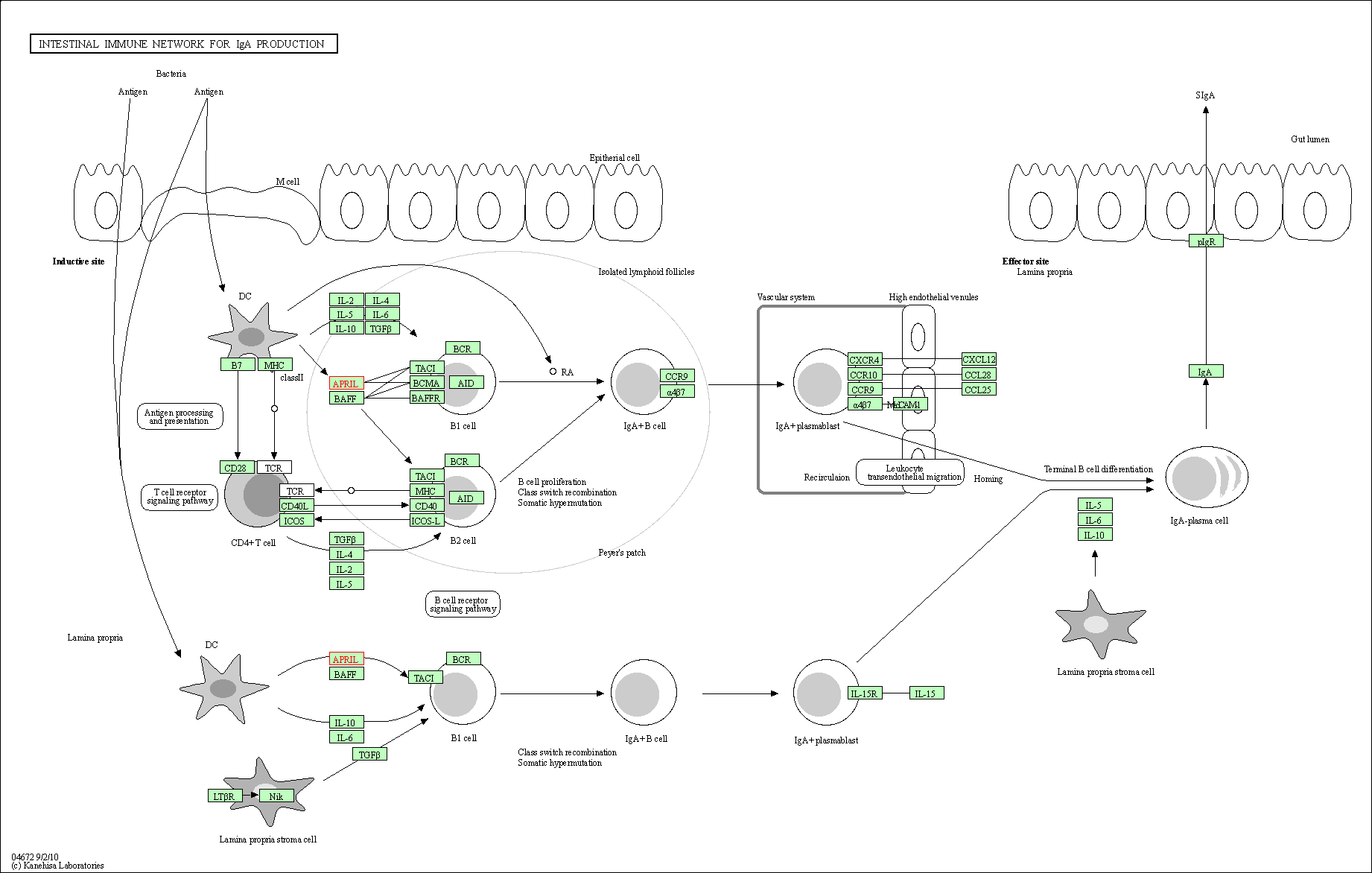Target Information
| Target General Information | Top | |||||
|---|---|---|---|---|---|---|
| Target ID |
T14676
(Former ID: TTDNC00650)
|
|||||
| Target Name |
A proliferation-inducing ligand (APRIL)
|
|||||
| Synonyms |
ZTNF2; UNQ383/PRO715; Tumor necrosis factor ligand superfamily member 13; TRDL-1; TNF-related death ligand 1; TNF- and APOL-related leukocyte expressed ligand 2; TALL2; TALL-2; CD256
Click to Show/Hide
|
|||||
| Gene Name |
TNFSF13
|
|||||
| Target Type |
Clinical trial target
|
[1] | ||||
| Disease | [+] 1 Target-related Diseases | + | ||||
| 1 | Lymphoma [ICD-11: 2A80-2A86] | |||||
| Function |
Plays a role in the regulation of tumor cell growth. May be involved in monocyte/macrophage-mediated immunological processes. Cytokine that binds to TNFRSF13B/TACI and to TNFRSF17/BCMA.
Click to Show/Hide
|
|||||
| BioChemical Class |
Cytokine: tumor necrosis factor
|
|||||
| UniProt ID | ||||||
| Sequence |
MPASSPFLLAPKGPPGNMGGPVREPALSVALWLSWGAALGAVACAMALLTQQTELQSLRR
EVSRLQGTGGPSQNGEGYPWQSLPEQSSDALEAWENGERSRKRRAVLTQKQKKQHSVLHL VPINATSKDDSDVTEVMWQPALRRGRGLQAQGYGVRIQDAGVYLLYSQVLFQDVTFTMGQ VVSREGQGRQETLFRCIRSMPSHPDRAYNSCYSAGVFHLHQGDILSVIIPRARAKLNLSP HGTFLGFVKL Click to Show/Hide
|
|||||
| 3D Structure | Click to Show 3D Structure of This Target | AlphaFold | ||||
| Drugs and Modes of Action | Top | |||||
|---|---|---|---|---|---|---|
| Clinical Trial Drug(s) | [+] 1 Clinical Trial Drugs | + | ||||
| 1 | Atacicept | Drug Info | Phase 3 | Lymphoma | [1], [2] | |
| Mode of Action | [+] 1 Modes of Action | + | ||||
| Modulator | [+] 1 Modulator drugs | + | ||||
| 1 | Atacicept | Drug Info | [1] | |||
| Cell-based Target Expression Variations | Top | |||||
|---|---|---|---|---|---|---|
| Cell-based Target Expression Variations | ||||||
| Drug Binding Sites of Target | Top | |||||
|---|---|---|---|---|---|---|
| Ligand Name: Tris-hydroxymethyl-methyl-ammonium | Ligand Info | |||||
| Structure Description | Single-chain human APRIL-BAFF-BAFF Heterotrimer | PDB:4ZCH | ||||
| Method | X-ray diffraction | Resolution | 2.43 Å | Mutation | No | [3] |
| PDB Sequence |
HSVLHLVPIN
16 AASDSDVTEV28 MWQPALRRGR38 GLQAQGYGVR48 IQDAGVYLLY58 SQVLFQDVTF 68 TMGQVVSREG78 QGRQETLFRC88 IRSMPHPDRA99 YNSCYSAGVF109 HLHQGDILSV 119 IIPRARAKLN129 LSPHGTFLGF139 VKLVTQDCLQ156 LIADSETPTI166 QKGSYTFVPW 176 LLSFKRGSAL186 EEKENKILVK196 ETGYFFIYGQ206 VLYTDKTYAM216 GHLIQRKKVH 226 VFGDELSLVT236 LFRCIQNMPE246 TLPNNSCYSA256 GIAKLEEGDE266 LQLAIPRENA 276 QISLDGDVTF286 FGALKLLGVT302 QDCLQLIADS312 ETPTIQKGSY322 TFVPWLLSFK 332 RGSALEEKEN342 KILVKETGYF352 FIYGQVLYTD362 KTYAMGHLIQ372 RKKVHVFGDE 382 LSLVTLFRCI392 QNMPETLPNN402 SCYSAGIAKL412 EEGDELQLAI422 PRENAQISLD 432 GDVTFFGALK442 LL
|
|||||
|
|
||||||
| Click to View More Binding Site Information of This Target with Different Ligands | ||||||
| Different Human System Profiles of Target | Top |
|---|---|
|
Human Similarity Proteins
of target is determined by comparing the sequence similarity of all human proteins with the target based on BLAST. The similarity proteins for a target are defined as the proteins with E-value < 0.005 and outside the protein families of the target.
A target that has fewer human similarity proteins outside its family is commonly regarded to possess a greater capacity to avoid undesired interactions and thus increase the possibility of finding successful drugs
(Brief Bioinform, 21: 649-662, 2020).
Human Pathway Affiliation
of target is determined by the life-essential pathways provided on KEGG database. The target-affiliated pathways were defined based on the following two criteria (a) the pathways of the studied target should be life-essential for both healthy individuals and patients, and (b) the studied target should occupy an upstream position in the pathways and therefore had the ability to regulate biological function.
Targets involved in a fewer pathways have greater likelihood to be successfully developed, while those associated with more human pathways increase the chance of undesirable interferences with other human processes
(Pharmacol Rev, 58: 259-279, 2006).
Biological Network Descriptors
of target is determined based on a human protein-protein interactions (PPI) network consisting of 9,309 proteins and 52,713 PPIs, which were with a high confidence score of ≥ 0.95 collected from STRING database.
The network properties of targets based on protein-protein interactions (PPIs) have been widely adopted for the assessment of target’s druggability. Proteins with high node degree tend to have a high impact on network function through multiple interactions, while proteins with high betweenness centrality are regarded to be central for communication in interaction networks and regulate the flow of signaling information
(Front Pharmacol, 9, 1245, 2018;
Curr Opin Struct Biol. 44:134-142, 2017).
Human Similarity Proteins
Human Pathway Affiliation
Biological Network Descriptors
|
|
|
There is no similarity protein (E value < 0.005) for this target
|
| KEGG Pathway | Pathway ID | Affiliated Target | Pathway Map |
|---|---|---|---|
| Cytokine-cytokine receptor interaction | hsa04060 | Affiliated Target |

|
| Class: Environmental Information Processing => Signaling molecules and interaction | Pathway Hierarchy | ||
| Intestinal immune network for IgA production | hsa04672 | Affiliated Target |

|
| Class: Organismal Systems => Immune system | Pathway Hierarchy | ||
| Degree | 2 | Degree centrality | 2.15E-04 | Betweenness centrality | 0.00E+00 |
|---|---|---|---|---|---|
| Closeness centrality | 1.75E-01 | Radiality | 1.28E+01 | Clustering coefficient | 1.00E+00 |
| Neighborhood connectivity | 6.50E+00 | Topological coefficient | 7.22E-01 | Eccentricity | 12 |
| Download | Click to Download the Full PPI Network of This Target | ||||
| Target Regulators | Top | |||||
|---|---|---|---|---|---|---|
| Target-regulating microRNAs | ||||||
| Target Profiles in Patients | Top | |||||
|---|---|---|---|---|---|---|
| Target Expression Profile (TEP) | ||||||
| References | Top | |||||
|---|---|---|---|---|---|---|
| REF 1 | Atacicept: a new B lymphocyte-targeted therapy for multiple sclerosis. Nervenarzt. 2009 Dec;80(12):1462-72. | |||||
| REF 2 | New developments in immunosuppressive therapy for heart transplantation. Expert Opin Emerg Drugs. 2009 Mar;14(1):1-21. | |||||
| REF 3 | Stoichiometry of Heteromeric BAFF and APRIL Cytokines Dictates Their Receptor Binding and Signaling Properties. J Biol Chem. 2015 Jun 26;290(26):16330-42. | |||||
If You Find Any Error in Data or Bug in Web Service, Please Kindly Report It to Dr. Zhou and Dr. Zhang.

